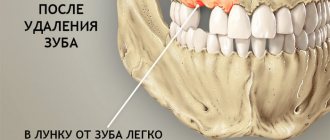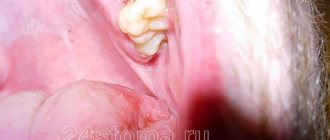Tooth extraction is performed for medical reasons when it is impossible to save it. Surgery is performed under anesthesia. It can have varying degrees of complexity depending on the location of the dental unit.
If the operation is performed correctly, a clot will form in the socket within the first 24 hours after tooth extraction. It is necessary to protect the wound from infection and promotes accelerated tissue healing. If the blood clot does not form or becomes damaged, complications may occur. Find out how to prevent them and what to do if inflammation develops.
Blood clot: mechanism of appearance, appearance
When and how does a blood clot appear in the socket of a tooth that has been removed? The mechanism of its formation is as follows:
- literally 2-3 seconds after extracting the root, bleeding of light or medium intensity begins,
- the empty hole formed in place of the tooth is immediately filled to the brim with blood, which normally stops over the next 30 minutes,
- the blood coagulates, thus forming a dense clot or thrombus slightly larger in size than the hole formed in the gum.
What does a clot look like after tooth extraction? It protrudes slightly from the gums. Looks like a small ball or lump. The photo below shows that it has a dark red or even burgundy color.
On a note! In the first few days after the operation, it is quite acceptable for ichor to be released from the wound and the saliva to turn pinkish, as well as the presence of a metallic taste and odor in the mouth.
Possible complications
- Pain is a natural part of the tooth healing process. Without it, recovery is possible only in rare cases. However, it should be mild and go away under the influence of painkillers. If the pain is acute, does not go away within several days and is not reduced by medications, this indicates that the healing process is not happening correctly.
- Dentists assure that normally bleeding from the socket should last from 3 to 30 minutes. Maximum – 1 hour. If it lasts longer than three hours, then there is an open threat to health. It is worth paying attention to its color. Scarlet blood is not the most pleasant sign.
- The jaw may feel numb for several hours after surgery. However, this should not last more than a day.
- The most dangerous symptom is an increase in body temperature to 38 degrees or more. Normally, this should not happen during the healing process.
- Another type of complication is the formation of profuse swelling, which makes it even difficult to open the mouth.
If at least one of the above signs appears, then you should immediately consult a doctor. Many patients do not pay attention to such complications and make a mistake, since the gum restoration process does not proceed correctly, and this can lead to unpleasant consequences.
The main functions performed by such a “thrombus”
If a clot has formed at the site of the extracted tooth, then this is a good sign. It is this that protects a fresh wound from the aggressive environment of the oral cavity, where a large number of bacteria live. It also prevents saliva and food debris from entering injured tissues, protects them from the inflammatory process and related complications (alveolitis, abscess, gumboil, phlegmon, osteomyelitis).
The clot promotes the natural healing process of areas damaged during surgery. Moreover, some researchers claim that it even accelerates the process of tissue regeneration, and if it is not formed or falls out ahead of time, the rehabilitation period lasts longer.
Diagnosis and treatment of alveolitis of the socket after tooth extraction
If you have had a tooth removed, but after 2 days the pain in the socket has not gone away, or additional signs of inflammation have appeared, you should not postpone your visit to the doctor. Self-medication can lead to complications such as periostitis, osteomyelitis, and damage to adjacent teeth. The sooner treatment begins, the faster and with less risk of unpleasant consequences the wound will heal.
Even if your tooth was removed in another clinic, our specialists will help you.
Typically, diagnosing alveolitis of the tooth socket is not difficult. A medical history and examination is sufficient. But if necessary, to clarify the depth of the lesion, you may be prescribed additional studies: radiography or radiovisiography.
SM-Dentistry uses only high-quality materials; all instruments are sterilized using powerful sterilizers that eliminate the possibility of infection.
Treatment measures for alveolitis at SM-Dentistry:
- Local anesthesia will relieve acute pain and help you endure treatment.
- Complete cleansing of the wound from parts of the destroyed blood clot, food debris, plaque - a clean wound surface should remain.
- Treatment with disinfectants, antimicrobial and anesthetic agents.
- Application of a special turunda (tampon with medications).
The doctor will give recommendations for further care:
- special baths with antiseptic;
- painkillers;
- gentle diet.
It is possible that treatment of socket alveolitis will need to be supplemented with physiotherapeutic methods.
Causes of untimely appearance of a blood clot
When a blood clot forms within half an hour after tooth extraction, this is normal. But it happens that a blood clot forms only several hours or even days after the operation, or the socket generally remains dry and unprotected. Why is this happening:
- long-term unstoppable bleeding: occurs against the background of some chronic diseases associated with impaired blood hemostasis and metabolic processes in the body, for example, diabetes mellitus. The problem is also caused by the patient taking drugs containing acetylsalicylic acid (for example, Aspirin) the day before or for a long time. In women, the pathology may be associated with surgery during menstruation. Read about all the causes of the problem and methods for solving it in the feature article on the website,
- vasoconstriction caused by the use of anesthesia: in this case, bleeding can begin only 1-3 hours after the operation,
- medical errors: a clot may not form because the specialist performed the operation too traumatically, cleaned the hole poorly and left tooth fragments inside. In general, experienced doctors, seeing that there are no prerequisites for the formation of a blood clot, resort to additional measures, for example, provoking bleeding or simply stitching the edges of the wound so that infection does not get inside.
How long does a clot last?
In the first 1-2 days after surgery, the clot in the tooth socket completes its final formation. At first it has a red tint, but after this time it brightens: first it acquires a pinkish and then whitish color.
On a note! On days 3-7 after tooth extraction, you may notice a white clot in your mouth. Many people have the feeling that a plaque has formed on top of it, which has an infectious and inflammatory nature. However, in reality this is not the case; the white film is a sign of the formation of fibrin protein in the saliva and sedimentation on the wound, which performs an additional protective function.
A blood clot on an extracted tooth, or more precisely, in the hole left after it, can persist on average for the next 7-10 days. The timing directly depends on the individual characteristics of the patient and his state of health, level of oral hygiene, absence or presence of complications. But in any case, every day after the operation the edges of the hole come closer together, and the clot itself dries out, that is, it becomes smaller and smaller, and new granulation tissue gradually forms in its place.
Usually, a month after the operation, no trace of the blood clot remains, and new epithelium and bone tissue are formed in the wound area. The complete process of formation of bone structures takes about 4-6 months, after which the bone becomes denser and merges with the jaw.
This is how, naturally, the normal process of tissue healing takes place, but if the patient develops some kind of deviation, then everything can go according to an individual scheme.
Consequences of a clot falling out of a wound
Doctors warn that if a blood clot falls out of the wound after tooth extraction, or it is damaged, then this is fraught with the following unpleasant consequences:
- “dry socket” syndrome: lack of protection makes the wound accessible to bacteria, saliva, and food particles. In 49% of cases[1] (according to some researchers) it provokes the development of alveolitis,
- alveolitis: an acute infectious and inflammatory process in the socket of the removed unit and the surrounding tissues. Alveolitis occurs not only in the absence of a blood clot, but also when its integrity is violated, but then you will most likely find a yellow, green or gray clot on the wound after tooth extraction. The pathology may be accompanied by the appearance of putrid odor from the mouth, suppuration, increased pain, inability to open the mouth normally, increased tissue swelling,
- flux, cyst, phlegmon, osteomyelitis: all these pathologies arise as complications of alveolitis if the disease has been neglected or was treated incorrectly.
On a note! If the clot comes out after tooth extraction or falls out before thin granulation tissue has time to form under it, then in 3-5% of cases alveolitis develops after this. Moreover, if a blood clot is damaged or missing after the removal of a wisdom tooth, then purulent inflammation of the socket occurs much more often - in 30% of cases.
If the clot in the extracted tooth is lost or damaged for some reason, this will have a bad effect on the speed of the tissue healing process.
Purpose, basic properties
Fibrin I-PRF in liquid form is obtained immediately after centrifugation, but before coagulation. If you plan to use it in this form, you need to work quickly, since coagulation occurs in two to three minutes. The product is used in a variety of ways, including direct injections into the gums for the treatment of periodontitis. Such actions not only promote rapid healing and elimination of inflammation, but also help in tissue renewal.
Fibrin membranes are actively used in surgery for maxillofacial plastic surgery. For this purpose, coagulated preparations are used, helping in rapid regeneration. The technology is in demand in implantation. The use of such a coating ensures safe and rapid integration of the artificial root with the surrounding bone tissue.
The properties of drugs in liquid and coagulated form differ. The doctor must take this into account, as well as the purpose of the clot, the characteristics of the work, the condition of the tissues and other factors.
Advantages and disadvantages
The use of fibrin membranes in dentistry is practiced by surgeons in almost all countries of the world. Excellent results are confirmed by many clinical studies and the opinions of doctors themselves. The advantages of this technology include:
- postoperative wounds using a fibrin clot heal quickly, rehabilitation time is reduced;
- the pain syndrome decreases after treatment, there is no swelling, there is no discomfort;
- the risks of infection and complications are eliminated, and a hemostatic effect is observed;
- healthy tissues are preserved as much as possible, new ones are regenerated quickly;
- the technology is affordable, today it is increasingly used for dental offices and mid-segment clinics;
- it takes a minimum of time to make a clot;
- after completion of the manipulations, new vessels are formed quickly;
- autogenous drug, compatible with the Patient’s tissues;
- manufacturing requires little cost and time;
- due to the presence of leukocytes, local immunity is stimulated;
- versatility, the ability to use the drug to work with hard and soft tissues, skin, mucous membranes;
- acceleration of regeneration and healing after surgical procedures.
There are practically no contraindications or disadvantages to the membrane technology. This happens because the drug is made from the Patient’s blood, that is, there are practically no risks of rejection or the development of inflammatory processes. There are also virtually no side effects.
What not to do and how to preserve the protective clot
To prevent the protective clot from falling out, dislodging, or damaging the protective clot after tooth extraction, you must adhere to the rules recommended by doctors. Here is a list of what you should absolutely not do:
- exclude sports and any physical activity,
- avoid eating solid, hot and cold foods,
- do not chew on the same side of the jaw where the intervention was performed,
- do not touch the wound with your finger or tongue, do not try to remove, clean or pull out a blood clot,
- try not to overheat, because this contributes to a rush of blood to the head, increased swelling and other unpleasant symptoms (pain, weakness): to do this, you need to temporarily avoid taking a hot bath, visiting the sauna and steam room, staying in the open sun,
- no active rinsing of the mouth in the first 2-3 days after surgery: about what, how and when it is better to rinse after tooth extraction - in the feature article on the website,
- introduce a ban on the consumption of alcoholic beverages and reduce to a minimum the number of cigarettes smoked per day, better yet, give up bad habits altogether in the next 7-10 days,
- Do not under any circumstances try to get rid of physiological swelling of tissues and painful sensations using heat compresses and warming up the cheek.










